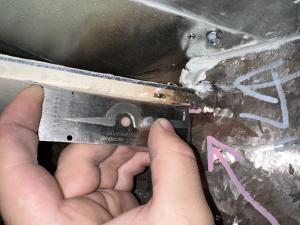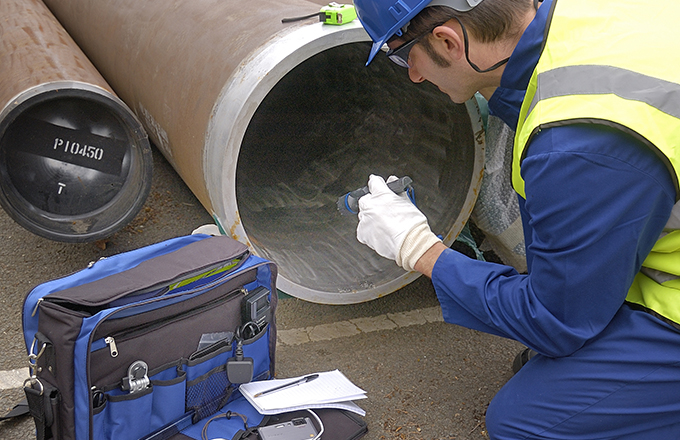How Welding Inspection Gilbert Arizona Can Improve Your Building and Production Processes
How Welding Inspection Gilbert Arizona Can Improve Your Building and Production Processes
Blog Article
A Comprehensive Overview to Welding Inspection: Comprehending Standards, Techniques, and Finest Practices for Quality Guarantee
Welding assessment plays a pivotal function in guaranteeing the architectural honesty and safety of bonded components, necessitating a comprehensive understanding of market standards such as those developed by AWS and ASME. Different assessment techniques, consisting of aesthetic and ultrasonic screening, are utilized to detect possible defects that might compromise high quality. Executing best techniques can substantially improve operational dependability and foster trust among clients. As we check out these critical elements, it becomes obvious that the implications of welding evaluation prolong much beyond compliance, inviting a more detailed examination of exactly how these processes form sector criteria and methods.
Value of Welding Assessment
Welding inspection plays a vital function in making certain the stability and safety of bonded frameworks. It is a necessary process that validates that welds adapt predefined specs, which is important in various markets, consisting of building and construction, auto, and aerospace. By performing detailed inspections, prospective problems such as cracks, incomplete fusion, and porosity can be determined early, avoiding catastrophic failings that might cause crashes or costly repairs.
The significance of welding assessment prolongs past mere compliance with policies; it also fosters depend on with stakeholders. Customers and governing bodies anticipate guarantee that the structures they count on are developed to endure functional tensions. Reliable welding evaluation techniques contribute to long-lasting durability and efficiency of the frameworks, eventually leading to decreased maintenance expenses.
Additionally, welding evaluation promotes a society of top quality within organizations, urging adherence to finest practices and continual enhancement. By incorporating assessment processes right into the welding operations, companies can improve their reputation and establish themselves as leaders in quality control. To conclude, the importance of welding inspection hinges on its capability to secure lives, make sure structural integrity, and maintain market requirements, making it a vital facet of welding procedures.
Trick Sector Standards
Making certain compliance with essential market standards is vital for keeping the top quality and safety and security of bonded frameworks. Various companies develop these requirements to advertise ideal practices in welding and inspection - Welding Inspection Gilbert Arizona. Amongst the most recognized are the American Welding Culture (AWS) and the American Culture of Mechanical Designers (ASME), which offer in-depth guidelines and requirements for welding processes and evaluation requirements
AWS requirements, such as AWS D1.1 for architectural welding, synopsis demands for materials, style, and testing to ensure the integrity of welds. ASME codes, consisting of ASME Area IX, control the credentials of welders and welding procedures, guaranteeing regular quality in commercial applications. Internationally, the ISO 3834 typical emphasizes high quality demands for combination welding, providing a structure for organizations to demonstrate conformity with worldwide best methods.
Conformity with these requirements not just boosts the reliability of welded frameworks however likewise minimizes threats connected with structural failings. In addition, adherence to market criteria is commonly a prerequisite for regulative approvals and can dramatically affect job requirements. Inevitably, understanding and implementing these essential standards are essential for efficient welding inspection and quality control.
Assessment Techniques Overview
Efficient welding assessment relies upon a selection of methods developed to evaluate the high quality and integrity of welds. These methods can be extensively categorized into devastating and non-destructive screening (NDT) techniques. Non-destructive screening strategies, which are extensively preferred in the market, enable the evaluation of welds without compromising the honesty of the product.

Amongst the most frequently used NDT techniques are aesthetic examination, ultrasonic screening, radiographic testing, and magnetic bit testing. Aesthetic assessment is typically the initial action in the examination procedure, enabling assessors to identify surface imperfections and analyze weld grain profiles. Ultrasonic testing utilizes high-frequency sound waves to detect interior problems and measure the thickness of welds. Radiographic screening entails making use of X-ray or gamma-ray imaging to disclose inner issues, while magnetic bit screening is effective for identifying surface and near-surface suspensions in ferromagnetic materials.
Each technique has its very own advantages and limitations, making it essential for inspectors to pick the most proper view website technique based upon the specific needs of the project, the materials involved, and the urgency of the welds being examined. This cautious option supports and ensures extensive analyses security and quality criteria in welding procedures.
Typical Problems and Their Ramifications
A thorough understanding of typical flaws in welds is vital for preserving structural integrity and safety and security in welded buildings. Welding flaws can considerably endanger the mechanical homes of the joint, bring about failings that might jeopardize both employees and tools.
Common defects include porosity, which materializes as little gas pockets entraped in the weld metal, weakening the general framework. Cracking is one more prevalent concern, typically resulting from rapid air conditioning or inappropriate joint design, bring about stress and anxiety concentrations that can lead to catastrophic failures. Insufficient combination occurs when the weld steel stops working to properly bond with the base material, creating weak points that might bring about splitting up under lots.
Other significant flaws consist of undercutting, where the weld grain erodes the base steel, and slag incorporations, which can hinder the weld's toughness. Each of these problems has particular ramifications; for example, porosity can decrease ductility, while breaking directly affects tensile stamina. Identifying and recognizing these problems during assessment is important for making certain and executing restorative steps conformity with industry requirements, ultimately safeguarding the architectural stability of welded assemblies.
Finest Practices for Quality Guarantee
Executing finest practices for quality control in welding processes is vital for accomplishing optimum outcomes and minimizing issues. One essential method is the establishment of clear welding treatments that follow industry requirements and requirements. These procedures should consist of detailed directions concerning material choice, joint prep work, and welding techniques to ensure consistency and high quality.
Routine training and qualification of welding workers are likewise crucial. Knowledgeable welders that comprehend the significance of high quality assurance are more probable to create audio welds. Additionally, executing a durable assessment program, including both visual and non-destructive screening (NDT), can help recognize defects early while doing so, permitting prompt corrective actions.

Finally, promoting a society of top quality within the company motivates staff members to prioritize top quality in their work. By you can find out more adhering to these best techniques, companies can improve the integrity of their welding processes, inevitably leading to enhanced item top quality and minimized costs associated with rework and repair work.

Conclusion
In final thought, welding evaluation plays a crucial function in guaranteeing the integrity and safety and security of bonded frameworks. By carrying out finest methods, companies can boost integrity, minimize upkeep prices, and grow trust among clients, ultimately adding to successful welding procedures.
Furthermore, welding assessment advertises a culture of high quality within organizations, motivating adherence to finest methods and constant improvement. In verdict, the relevance of welding evaluation lies in its capacity to protect lives, make sure architectural dependability, and copyright sector requirements, making it a crucial element of welding procedures.
Among the most acknowledged are the American Welding Society (AWS) and advice the American Society of Mechanical Engineers (ASME), which offer detailed standards and specifications for welding processes and inspection standards.
Inevitably, understanding and applying these essential requirements are crucial for reliable welding assessment and quality guarantee.
Reliable welding assessment counts on a selection of methods created to evaluate the high quality and honesty of welds.
Report this page